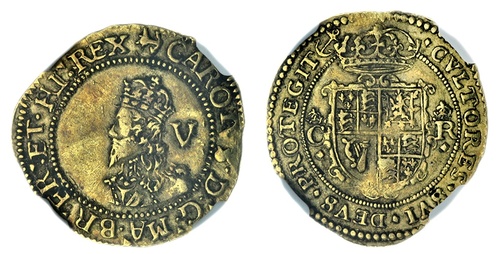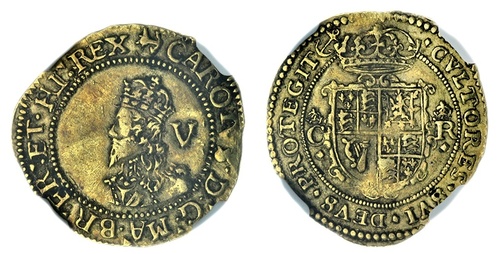Auction: 23004 - Ancient and British Coins - Featuring the 'White Rose' Collection
Lot: 512
NGC XF45 | Charles I (1625-1649), Group E/Briot Hammered Issue Mule, Gold 'Britain' Crown or Quarter-Unite of 5-Shillings, 9 May 1638 - 4 July 1639, Tower [under King], a 'Striking Test' by Edward Greene and Nicholas Briot, (m.m.) CAROLVS . D .' G .' MA '. BR .' FR .' ET . HI .' REX, large lettering, fifth crowned "unnecessarily small" 'Aberystwyth' bust left, wearing falling lace collar, from a Halfgroat puncheon, V behind, rev. . CVLTORES . SVI . DEVS . PROTEGIT (m.m.), small Roman lettering, second crowned square-topped fourth shield, dividing crowned C-R [as Briot's 1631-32 Milled Issue], 2.28g [35.2grns], 9h, m.m. anchor [straight flukes / rounded flukes] (BMC 1923,0212.2 same obverse die; Lockett 2240 same obverse die; Herbert Schneider, BNJ [1959, Part 3], pp. 402-403, Obverse 8 / Reverse Unlisted, cf. Plate XXV, no. 12; Brooker - [cf. 227-228 same obverse die]; Schneider II, - [cf. 266 same obverse die]; North 2188/-; Spink 2717/2721C), slightly crimped on an irregular flan, otherwise uniformly struck with handsome orange tone, an extraordinary Carolean rarity, this muling exhibiting the long-sought after Nicholas Briot 'Personal Reverse Die', the compliment to the French discovery coin noted by Herbert Schneider for the BNJ in 1958/59, of the highest rarity and importance to the Charles I small gold series, the true coin known only from a handful of specimens, this mule previously unpublished and presently UNIQUE, in NGC holder, graded XF45 (Cert. #6134590-006)
The following transcript is taken from Herbert Schneider's thesis on the Tower Mint Gold Coinage of Charles I (BNJ, 1958-1959, Part 3, pp. 382-404):
Group E -(Obv. Bust 8 with King's Crown 8. Rev. Shield 4 with Reverse Crown 2.) [Obv. Pl. XXV, 11. Rev. PI. XXV, 17.]. When the 'Aberystwyth bust design' was introduced on other denominations, a few obverse dies with this portrait model were also cut for the gold crowns. But it would appear that they were given no more than a striking test and subsequently discarded, for gold crowns with the 'Aberystwyth portrait' are very rare indeed. The bust is unnecessarily small for the coin and the punches were no doubt made to fit the size of half-groat rather than gold crown dies. It may have been for this reason that the portrait did not strike up very well and that the coins were found unsuitable for use on a large scale. Group E is known with the Anchor mark only.
Investigation of the British Museum collection forwards no parallel for this unrecorded Briot reverse die
Subject to 20% VAT on Buyer’s Premium. For more information please view Terms and Conditions for Buyers.
Sold for
£9,000
Starting price
£1500







